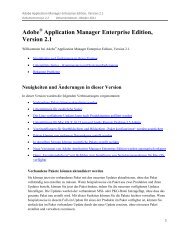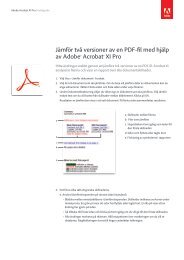XMP Specification Part 3: Storage in Files - Adobe
XMP Specification Part 3: Storage in Files - Adobe
XMP Specification Part 3: Storage in Files - Adobe
Create successful ePaper yourself
Turn your PDF publications into a flip-book with our unique Google optimized e-Paper software.
• When there is more than one <strong>XMP</strong> packet <strong>in</strong> a file, it may be impossible to determ<strong>in</strong>e which is the “ma<strong>in</strong>”<br />
<strong>XMP</strong>, and what the overall resource conta<strong>in</strong>ment hierarchy is <strong>in</strong> a compound document.<br />
• Some packets could be obsolete. For example, PDF files allow <strong>in</strong>cremental saves. Therefore, when<br />
changes are made to the document, there might be multiple packets, only one of which reflects the current<br />
state of the file.<br />
1.2.1 Scann<strong>in</strong>g h<strong>in</strong>ts<br />
A file should be scanned byte-by-byte until a valid header is found. First, the scanner should look for a byte<br />
pattern that represents the text<br />
<br />
The scanner is now ready to read the value of the beg<strong>in</strong> attribute, followed by the clos<strong>in</strong>g quote character:<br />
UTF-8 0xEF 0xBB 0xBF<br />
UTF-16, big-endian 0xFE 0xFF<br />
UTF-16, little-endian 0xFF 0xFE<br />
UTF-32, big-endian 0x00 0x00 0xFE 0xFF<br />
UTF-32, little-endian 0xFF 0xFE 0x00 0x00<br />
If the attribute has no value (that is, the value is the empty str<strong>in</strong>g), the encod<strong>in</strong>g is UTF-8.<br />
12 ©<strong>Adobe</strong> Systems Incorporated, 2010

















